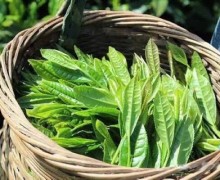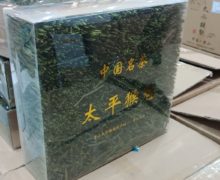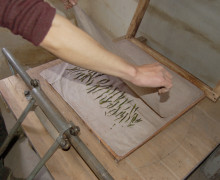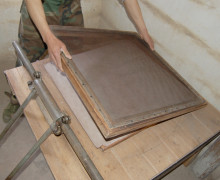Tai Ping Houkui
Green Tea 2023
Dramatic, unusually large leaves yield a brilliant, clear green tea with a soft clean flavor and a fresh bamboo aroma with floral notes. Entirely handmade in a labor-intensive hand-crafting process that creates its unique very large flattened leaf shape.
- 2024 $23.00
- Tea Origin
- Hougang Village, Taiping Hu Zhen, Yellow Mountain City, Anhui Province, China
- Tea Bush
- Shi Da Cha (Persimmon Large Leaf Tea Bush)
- Tea Maker
- Wang Shuangxi
- Harvest Time
- Late April
- Plucking Standard
- One bud, two leaves
The delicate rolled-out flat shape of Tai Ping Houkui’s large and intensely green leaves stands out among green teas. Because of the unique particularity of Tai Ping Houkui’s processing to produce this shape, many of its steps can only be done by hand, such as the laying out of individual leaves. However, this batch was crafted entirely by hand. This wholly handmade version of this famous tea showcases its soft and clean-flavored heirloom cultivar with a sea mineral aftertaste and signature fresh bamboo aroma.

Even within the constraints of its unique style, small adjustments in processing make enormous differences in the final character of the tea. Hand-frying the tea in a hot iron wok results in a telltale slight blistering of the leaves which develops a deeper flavor and more complex aroma. This version of Tai Ping Houkui was also traditionally flattened by hand into its distinctive shape with a small roller, better preserving the integrity of the leaf. Even under the stress of infusion, the leaves maintain their whole shape and deep green color — a fascinating tea to look at as well as drink.
The result of these processing techniques is a tea that is lighter yet also more complex than other versions of Tai Ping Houkui. The flavor of its clear brilliant green infusion is richly layered yet delicate, and its aroma blends notes of cornsilk, orchid, and fresh grains with the green impression of a bamboo forest breeze. Even if over-steeped or too many leaves are used in its infusion, it will never go bitter. Houkui is best enjoyed in a tall glass to appreciate the beautiful green tea leaves.
The unique process of making Tai Ping Houkui green tea
Farmers must wait slightly longer to harvest Tai Ping Houkui than is normal for other early spring tea, because this tea cultivar’s relatively large sprigs take longer to fully develop. The harvest begins around April 20th, during the Gu Yu solar period of China’s traditional agricultural calendar. The plucked leaves adhere to a standard of sprigs of one bud with three open leaves. This particular lot of Houkui was specifically chosen from the earliest picking in the season, when the flavor of the leaves is at its softest. Much Houkui on the market today is made from the more abundant summer harvests. Tea picked in the summer, though less expensive, can have a very heavy flavor, lacking the lightness traditional Houkui is known for.

Once the producers return from the fields to their workshop, they sort the tea by plucking the oldest leaf off the sprig, further refining the plucking standard. During this process, the fresh leaves also get a chance to rest and wither for a while, making them more pliable for processing.
Tea makers then fry the leaves at 110°C in an iron metal wok (about 70cm in diameter and 35-40cm deep). They only fry 100 grams of fresh leaves at a time, constantly moving the leaves in the wok for about three minutes at a time. This heat denatures the enzymes in the leaf that cause oxidation (darkening), thus allowing the leaves to remain fresh and green in color, flavor, and aroma. This step is known as sha qing (lit. “kill green”).

Next, to begin shaping the leaves, producers drop the temperature of the wok and fry the leaves for a couple more minutes using very complicated hand movements to squeeze the buds and leaves together. The tea leaves become very soft at this stage.
After this, the tea is roasted in a wooden four-drawer cabinet-like structure with a charcoal pot underneath as a heat source. Workers carefully adjust the charcoal to make each level of the cabinet a different temperature: the lowest level at 100°C, the second at 90°C, the third at 80°C, and the fourth at 70°C. Batches of leaves are moved between levels of the cabinet, gradually removing their moisture with different levels of heat. The roasting process takes about an hour.
Once the leaves finish their staggered roasting, workers lay out each leaf flat and press them into their distinct “bookmark” shape using two layers of fine steel mesh screens. Originally, before these steel screens had been invented, Tai Ping Houkui makers used sheets of thick paper and the pressure of their hands to press each leaf flat.
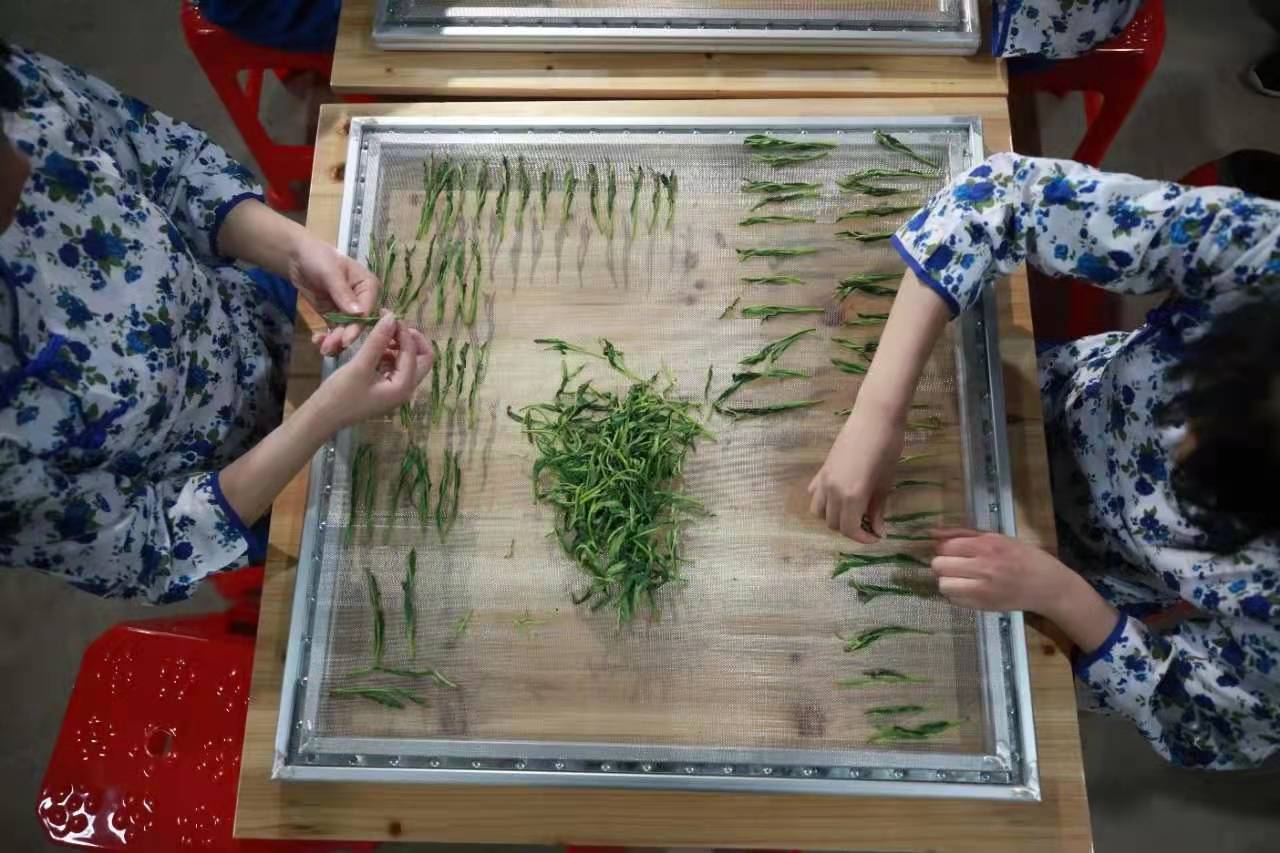
Finally, after roasting and shaping, the leaves are allowed to cool down for a few hours before they are consolidated into large batches and roasted one final time to reduce their moisture content to a stable level. After the final roast, tea makers will wrap the finished Tai Ping Houkui in cloth or paper and place it in a big ceramic pot. The ceramic pot has powdered limestone at its bottom to absorb moisture. The leaves rest over the limestone upon a wooden plank padded with large bamboo leaves. A short rest in this traditional storage is the final and most subtle step in Tai Ping Houkui’s production. As the leaves rest in this container, they are imbued with the gentle aroma of the Tai Ping County’s bamboo.
Houkui tea’s origins

As with many famous teas, Tai Ping Houkui is named after its place of origin. Tai Ping County sits northeast of the Huangshan mountain range. Even though the county resides in a mountainous region, the tea gardens are only about 300 meters above sea level. While Tai Ping Houkui was invented relatively recently in the early 1900s, it has quickly become well regarded in China, regularly appearing on lists of the country’s most prestigious teas.
There are two local myths associated with Tai Ping Houkui. The first is a legend about a benevolent flock of birds who carried the first tea seeds into Tai Ping County, scattering them amongst hills and crags where they would sprout. When these bushes began growing, and the villagers realized it would be too dangerous to pick. The villagers took local monkeys and hung cloth bags around their necks and sent them up the cliffs to pick the tea. While this is a wonderful idea to entertain, we can assure you no monkeys were used to pick this tea!

The second legend also tells of the monkeys of Tai Ping. As this story is told, when a mother monkey died of grief after losing her child, a local farmer kindly buried the animal on his land. The farmer soon dreamed of the monkey guiding him to a place deep in the forest, where there was a tea garden. Upon awaking, he retraced his dreaming steps to verily discover a hidden garden of tea bushes, which he plucked to make this tea.
No chemical fertilizer, pesticide, or herbicide was used in the production of this tea. Click here to read more about our promise to fair trade and the environment.












